We should start with a quick poll, ready? How many of you watched Sheffield United play more than once when they were in the Championship last season? Now, of those with their hands up how many watched them because they had heard the phrase ‘overlapping centre backs’. I would wager that this would cover most of you. I watch a lot of football and even I only watched then play three times last season (yes, I keep a track of these things). Our watching habits from last season are more than likely reflected by those in the media and as such the promotion of Sheffield United to the Premier League, last season was met with the expectation that their coach Chris Wilder was a typical British coach and that Sheffield United were workmanlike and unimaginative. In fact, this could not be further from the truth. While it is true that Sheffield United play in a very specific style and that they tend not to deviate from that style there is nothing unimaginative about their game model.
Out of possession, I have yet to see another team look as impressive as this Sheffield United side. Earlier this season I watched them play at home to Liverpool and it took a goalkeeping error for the league leaders, and likely champions, to force a breakthrough. This time I watched them play away at the current champions Manchester City and the City coach Pep Guardiola was forced into a complete rethink at half time to find a way around the United defensive block. Even with this tactical change City still needed the inadvertent intervention of the referee to enable their build-up to the first goal of the match.
In this tactical analysis, we will examine the key tactical points in the match. We will initially examine the methods that Guardiola looked to use to control the match and the defensive system that the Spaniard was trying to break down. We will then look at the halftime change that City made in order to stress key areas of the United defensive block.
Lineups
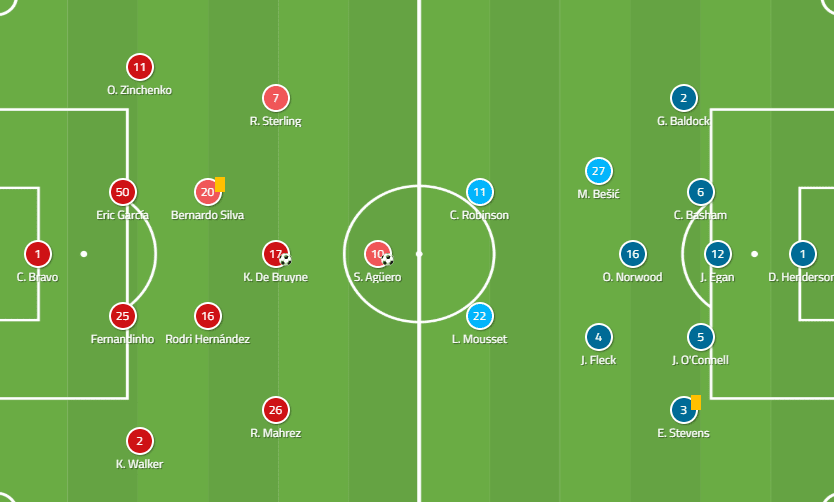
The formation graphic lifted from Wyscout is slightly off as City started in their regular 4-3-3 shape with Rodri at the base of the midfield. Bernardo Silva played centrally, as one of the advanced ‘8’s, alongside Kevin De Bruyne. There was a surprise selection in the defence as the young Spaniard Eric Garcia was picked to play alongside Fernandinho. With their regular goalkeeper Ederson out suspended, following a sending off against Wolves, the Chilean international Claudio Bravo was selected to take his place.
Sheffield United played in their regular 5-3-2 shape with Chris Basham, John Egan and Jack O’Connell across the defensive line. George Baldock and Enda Stevens provided width from the fullback position and in attack Lys Mousset and Callum Robinson were selected to start. This front paring provided a genuine threat when playing in quick transition with their pace and intelligent movement.
The xG story
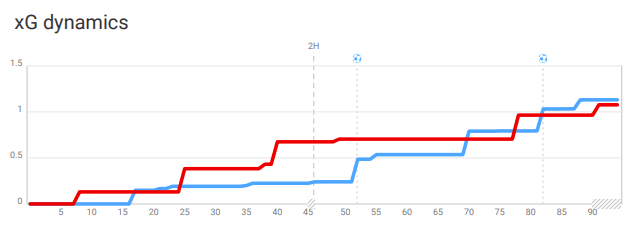
How often over the course of Pep Guardiola’s tenure at City have we seen them fail to dominate a match in terms of expected goals? Normally given their dominance of the ball and attacking threat we see City end up with a significant advantage in terms of expected goals. As you can see from the chart above, however, this match was different and Wyscout has City coming out of the match with a total of 1.13xG compared to 1.08xG for United. Here is where you have to be careful with your data provider though. There are some questions over the method Wyscout uses to collect this data. Indeed, Understat scores the xG at 1.09xG to City and 1.23xG to United. My own take on this variance is to choose one provider and be consistent with them throughout my analysis, hence my reliance on Wyscout.
The xG difference deserves a closer look.
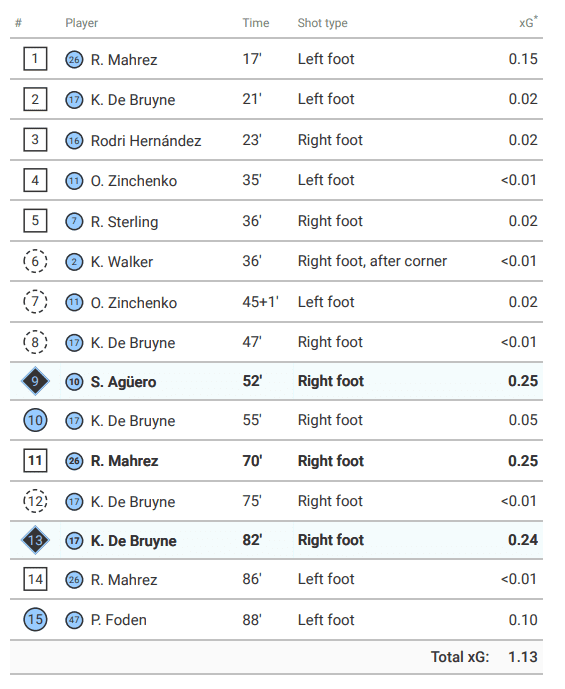
City then created 1.13xG from a total of fifteen shots at goal. You can see the xG value assigned to each shot in the chart above. The interesting thing to note is that only three of those fifteen shots carried an xG of more than 0.15. The opening goal, from Sergio Aguero, was assigned 0.25 and the second goal, by Kevin De Bruyne, was assigned 0.24. There was a 70th minute chance from Riyad Mahrez that was given 0.25. How then did City manage to take so many low probability shots?
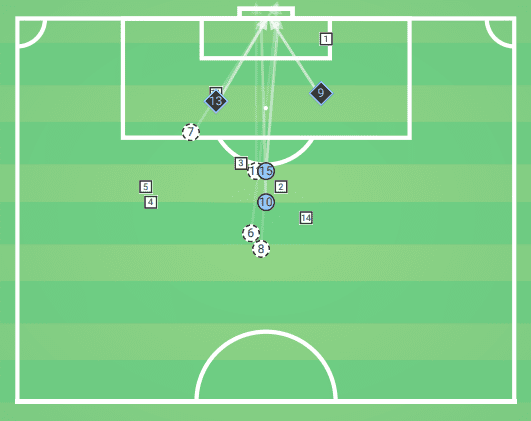
The City shot map from the match is instructive. First of all look at the level of shots that were from outside the area. City are renowned for their ability to play incisively in the final third with crosses pulled back into central areas especially effective. The inability of City to access the opposition penalty area in this match was a constant theme throughout. It is interesting to note that the two goals for City were two of only three total shots that were taken from positions that would be considered as intelligent shooting areas.
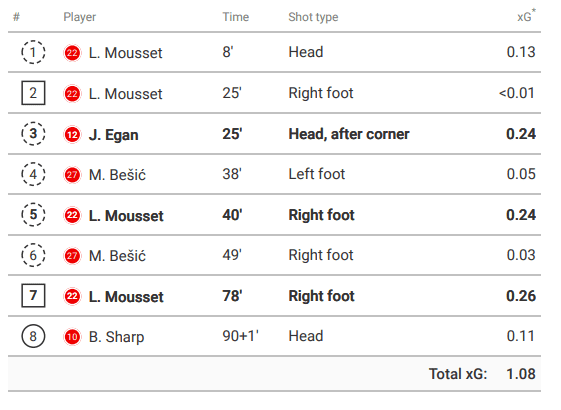
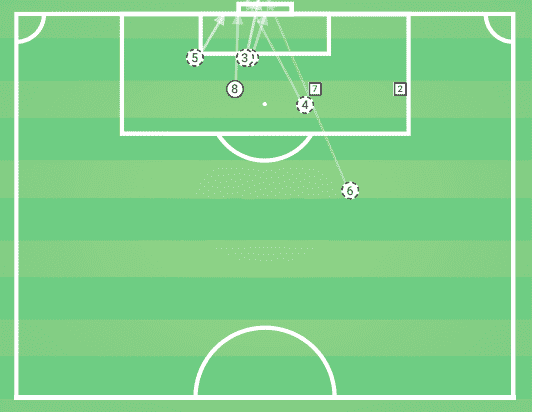
Compare the City shots and shot map to those of United from the match. United took only eight shots to gain a score of 1.08xG. Note though that six of these shots came from positions that would be considered as strong when discussing expected goals.
City control the tempo
For all that United impressed out of possession, they did not press in order to regain the ball. Indeed, their passes per defensive action (PPDA) score for the match was 26.9 over the course of the match. This shows that United were largely passive out of possession as they looked to block passing lanes and prevent City from playing into the centre. As a result of this City dominated the possession of the ball throughout the match as they ended up with 68% possession of the ball. The problem was that for all of this possession they struggled to penetrate and create genuine goalscoring chances.
Throughout the first half, we saw Guardiola seek to gain dominance by inverting the fullbacks to play on the same line as the deepest midfielder, Rodri. This is a tactical tool that we have seen Guardiola use situationally when he expects to out possess his opponents. By moving the fullbacks inside the 8’s are released into advanced positions.
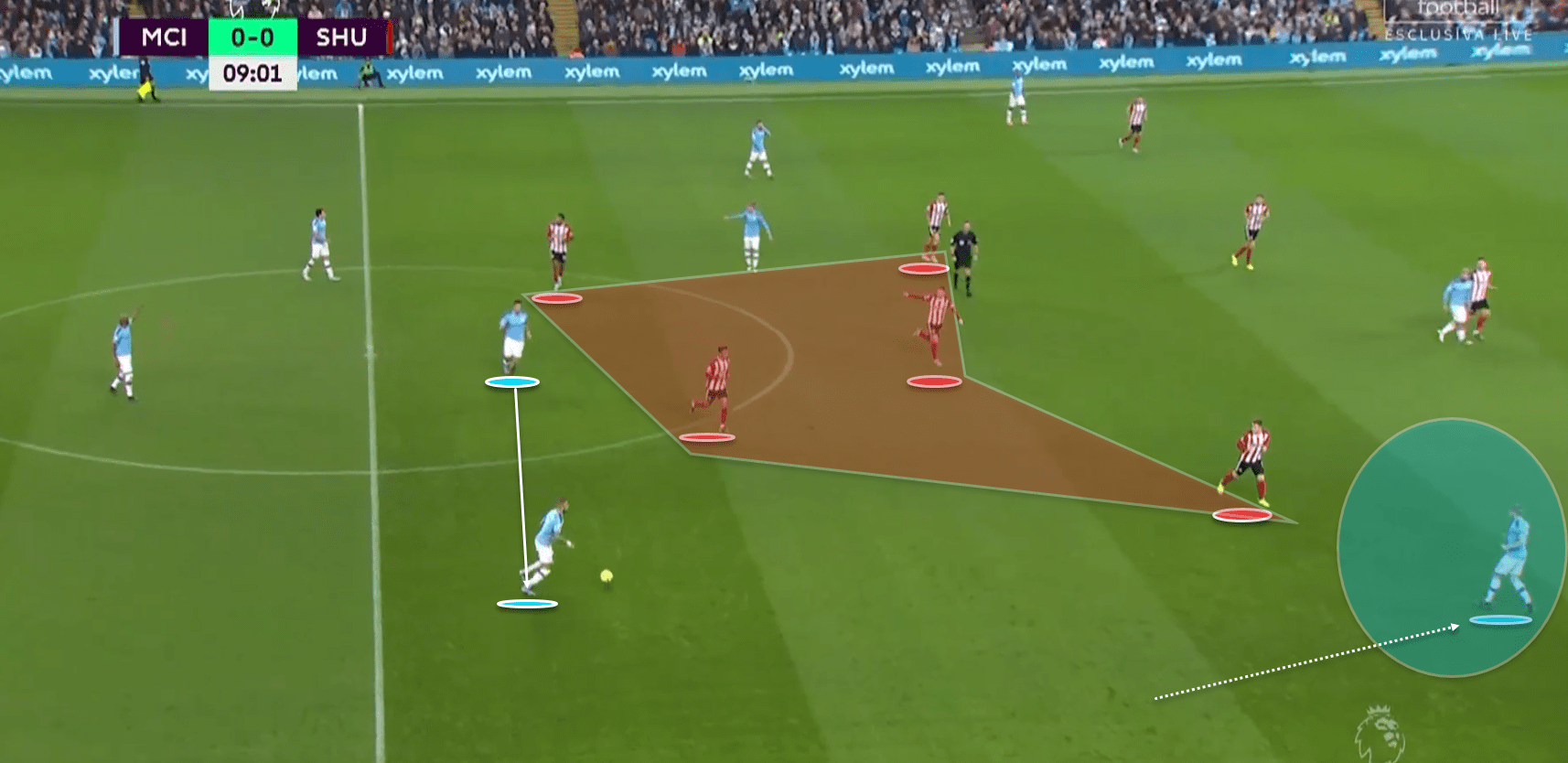
We see this above as Rodri looks to connect a pass to Walker out on the right side. You can see the first part of the defensive block as United defend in their structured 5-3-2- shape. The two forwards are passive in terms of pressing but work hard to shift across to prevent the ball from being played through centrally. The three central midfielders are then compact initially but look to press across in order to close spaces wide if City look to play around the block.
As the ball is played out to walker we see De Bruyne immediately move higher as he looks to occupy a pocket of space beyond the midfield line. the issues that City faced lay in the speed that the United midfield cycled across to block. The ball side central defender, in the back three, would also step out to engage the ‘8’ should the ball be played into them.
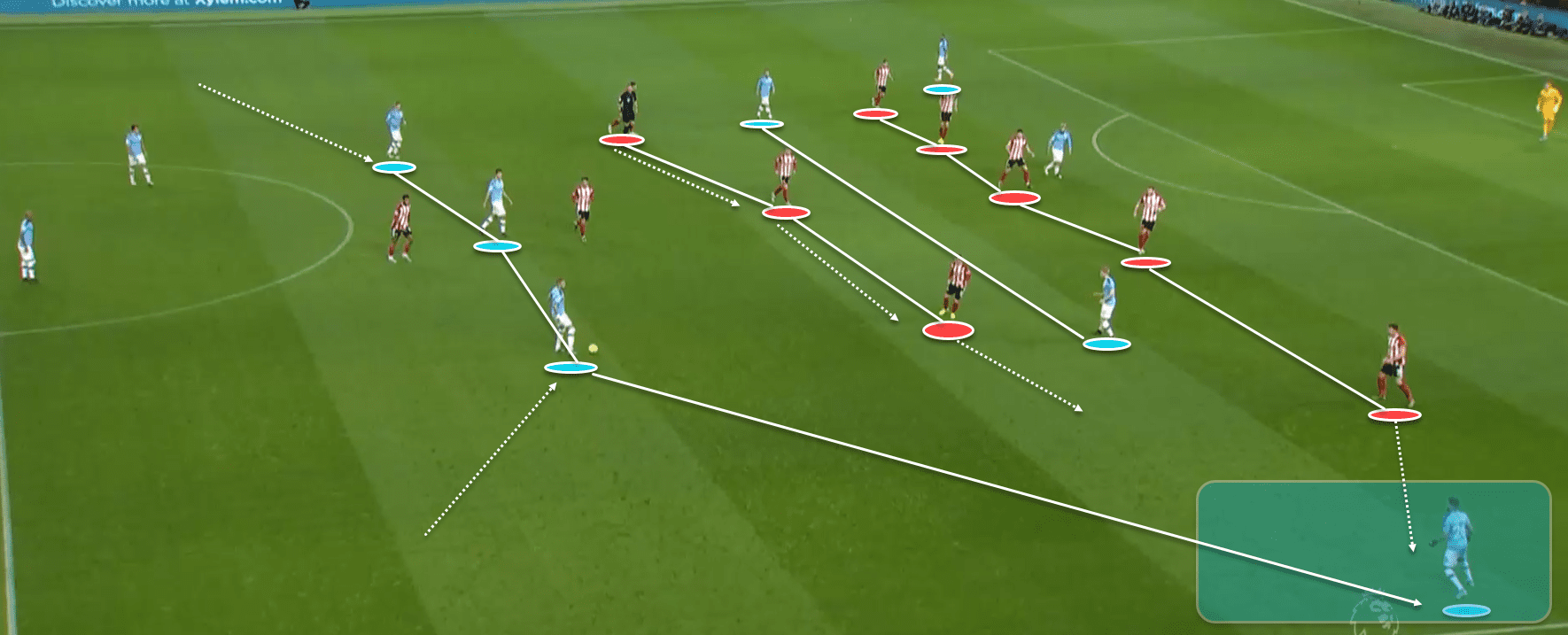
We see this in action properly above and this time we see both fullbacks, Walker and Zinchencko, have moved inside to join Rodri at the base of the midfield. As the ball is progressed from Walker out to Riyad Mahrez on the right side. As the ball is played we initially see that Mahrez is receiving in a 1v1 situation against Enda Stevens. As the ball was being played out however the midfield line was already shifting across as the near side central midfielder dropped in to support the left-back. This prevented the ball from being played back inside to combine centrally and allows United to press the ball in this advanced space.
The defensive model used by United in this match definitely needs to be examined in more depth.
United defend in balance
In the defensive phase, we see Chris Wilder prefer a system of balance and cover over the high pressing system that we tend to see from a lot of teams. They prefer to sit in a medium to deep block to maintain their defensive compactness using the ball as the focal point and not marking in a man to man style. Sheffield United are so well drilled on the training pitch that the entire block moves and works as one to prevent the opposition from easily progressing the ball. The fact that they do not press high means that they are rarely beaten by balls over the top of the defensive line. This forces the opposition to try to find a way through or around the block. In this match, City struggled throughout to consistently find a way through the defensive block.
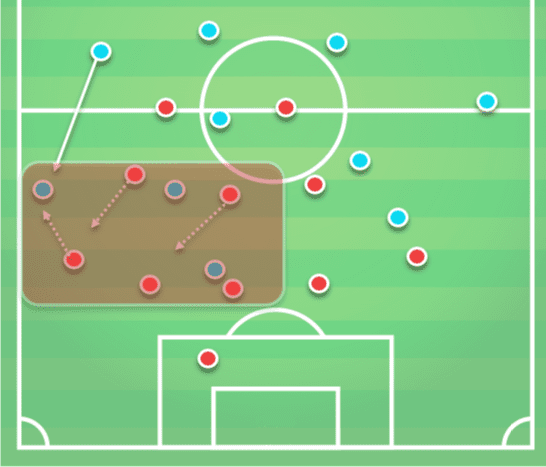
The above graphic shows a typical pass from the fullback to the wide forward. These passes are used by City to quickly create 1v1 opportunities when their wide forwards are isolated 1v1 against the opposition fullbacks. The wide player would then look to either engage the defender or play in combination with the near sided central midfielder or striker. Throughout this match, we saw United work to take these options away when City looked to play around the block.
As the ball was played wide the three central midfielders would shift across as one to close down space in the wide-area that City had in which to play. they drop towards the ball to create an effective block in front of the man in possession.
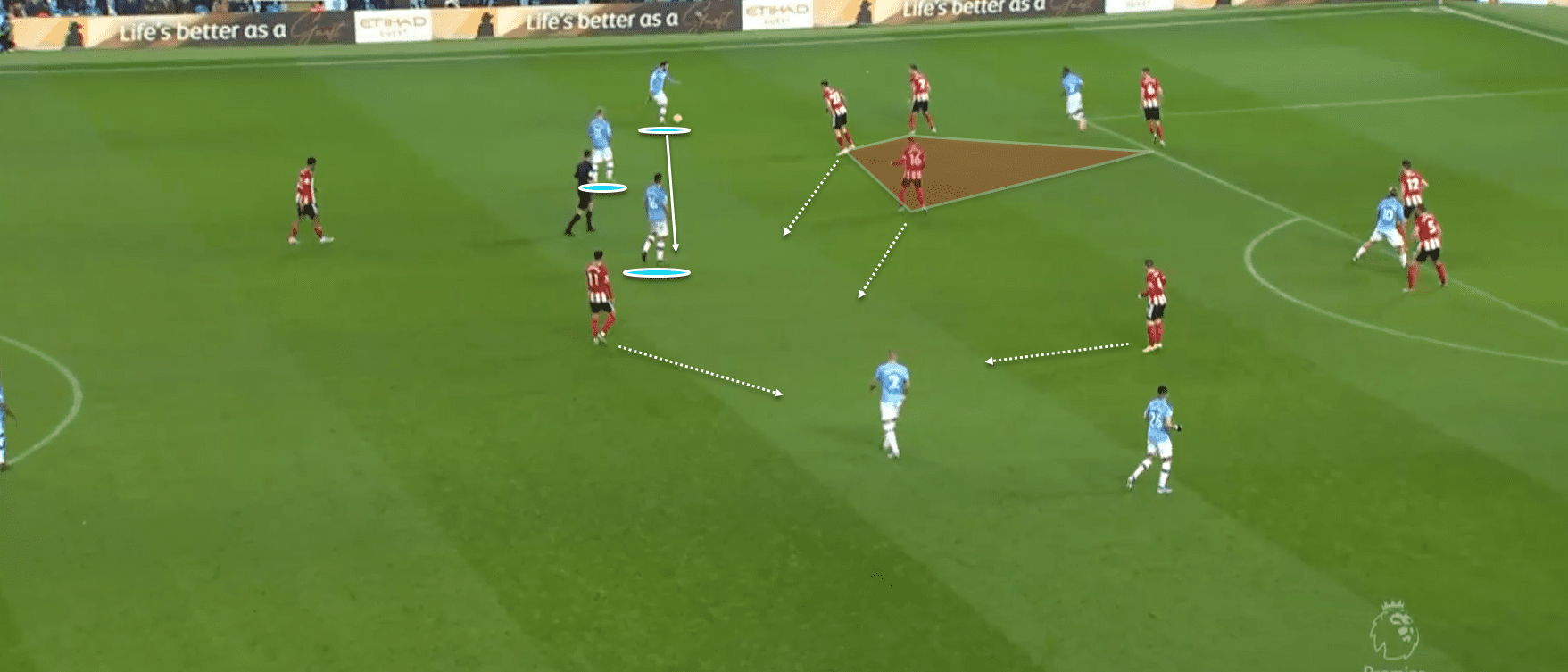
We see this in the image above as City have possession of the ball high on the left-hand side. As you can see the midfield block for United has already shifted across to close down the space in the wide area. Again this defensive movement is dictated by the position of the ball and not the opposition players. As City then look to play back into the centre of the field we see the midfield block rotate around again to cut off the central areas. In these areas, we then saw United apply pressure to the ball in order to force City to make a mistake.
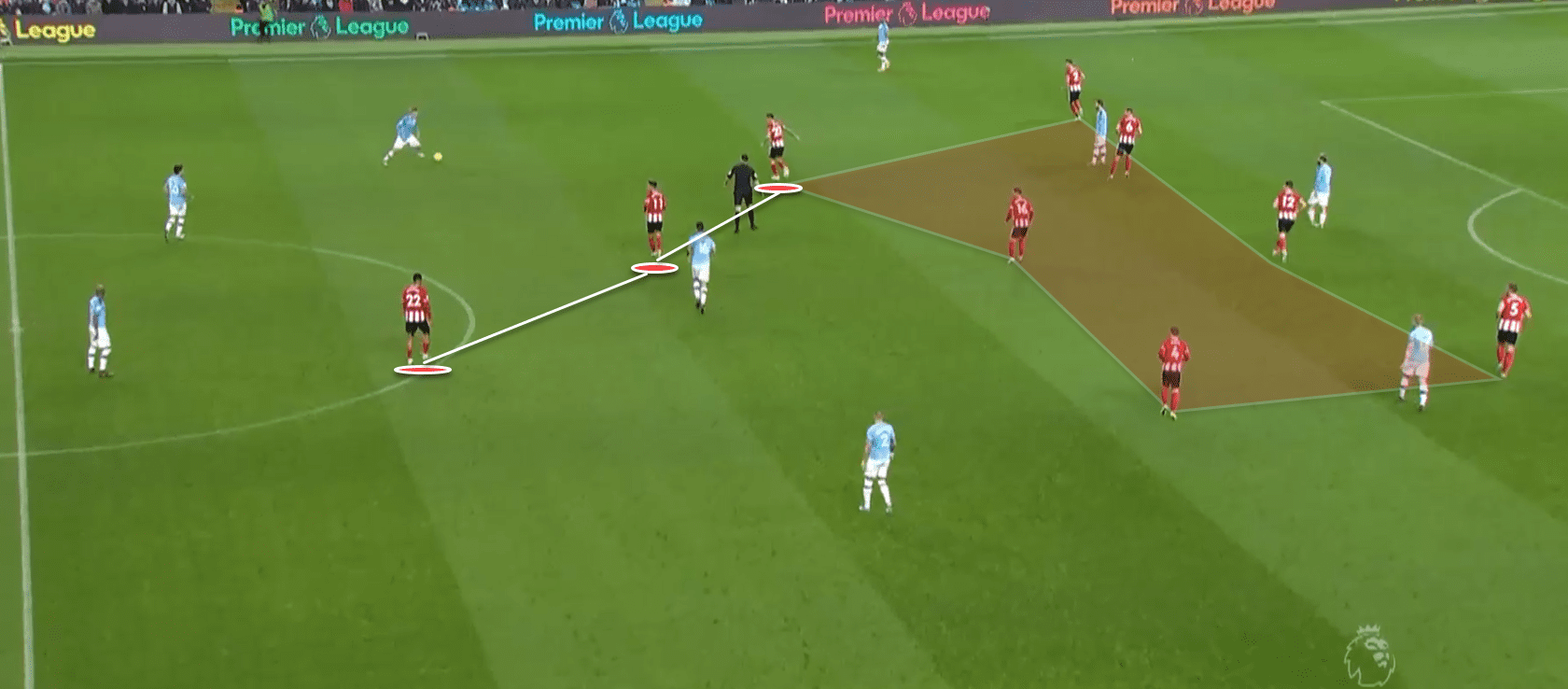
Above we see an example of the defensive block constructed by Sheffield United as Manchester City look to attack down their left-hand side. You can see the deep block from United already in place but the forward players, in conjunction with the near side central midfielder, are positioned to cut off the option for City to play the ball back across to the opposite side of the pitch. This structure is designed to force the opposition down the outside where the defensive block can shift over to close down space.
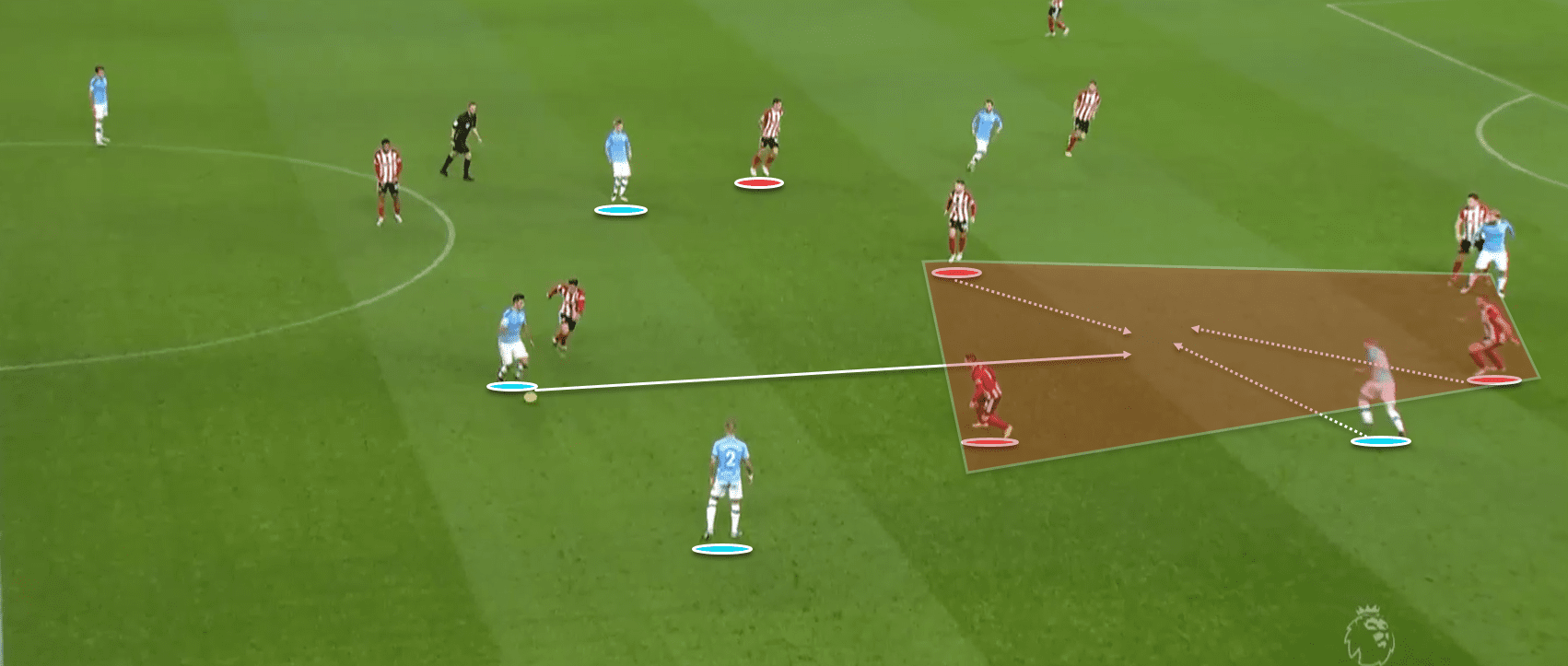
When City were able to play vertically into spaces between the midfield and defensive blocks we saw how quickly United would react to close down the space around the receiving player. We see an example of this above as the ball is played centrally to Kevin De Bruyne as the Belgian has made a run centrally in between the lines of the opposition. The ball is quickly played forward and normally from these areas we see City combine quickly to overload the opposition and break through the defensive line. Here, though, we see how quickly the defensive block collapses on the ball with two players immediately engaging and winning possession.
City change system
It is a measure of how impressive Sheffield United were in this match that we saw Guardiola choose to completely change the system at half time as Rodri dropped back to form a back three. The two central midfielders maintained their position but the wide forwards moved inside to try to occupy the spaces between the midfield and defence of United.
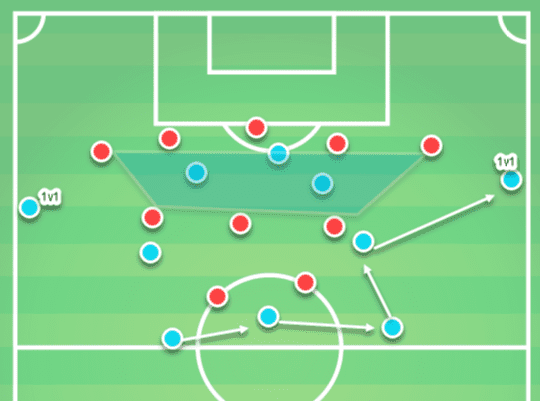
This graphic shows the ideas behind this tactical change. In the wide areas it was no longer the wide forwards who were pressing forward to seek 1v1 opportunities against the United fullbacks. Now the City fullbacks were released from their central positions to move high and wide. Combined with the central positioning of the two wide forwards we saw City seek to gain positional superiority in a slightly different way.
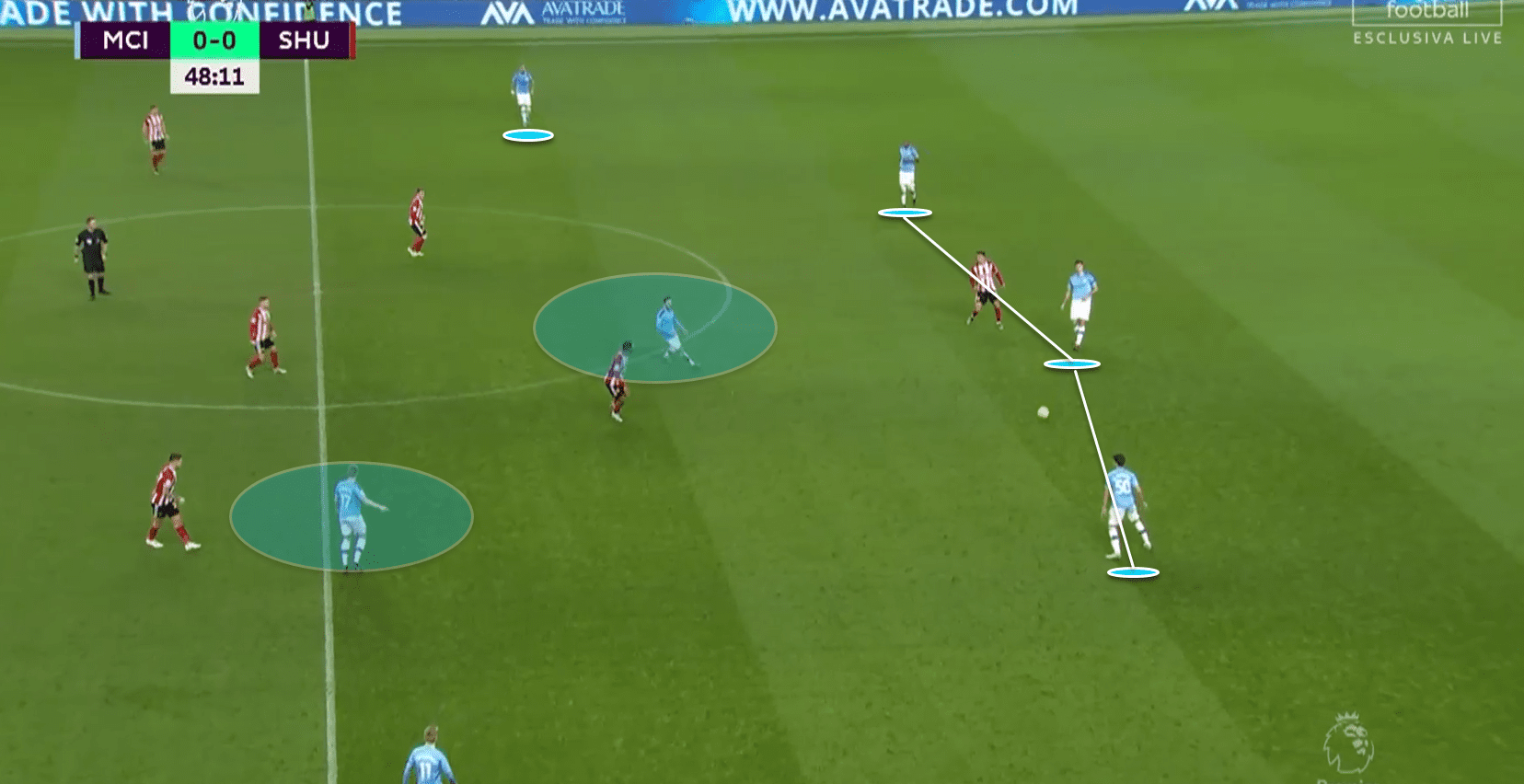
Here we see the new orientation of the backline for City as Rodri drops deep. This allowed for cleaner progression of the ball as City now have a 3v2 advantage against the United forwards. The ball could then move from one side to another before being progressed forward into the midfield. With Sheffield United keeping their fullbacks deep this meant that the City fullbacks were able to take possession of the ball deep before advancing forward into space.
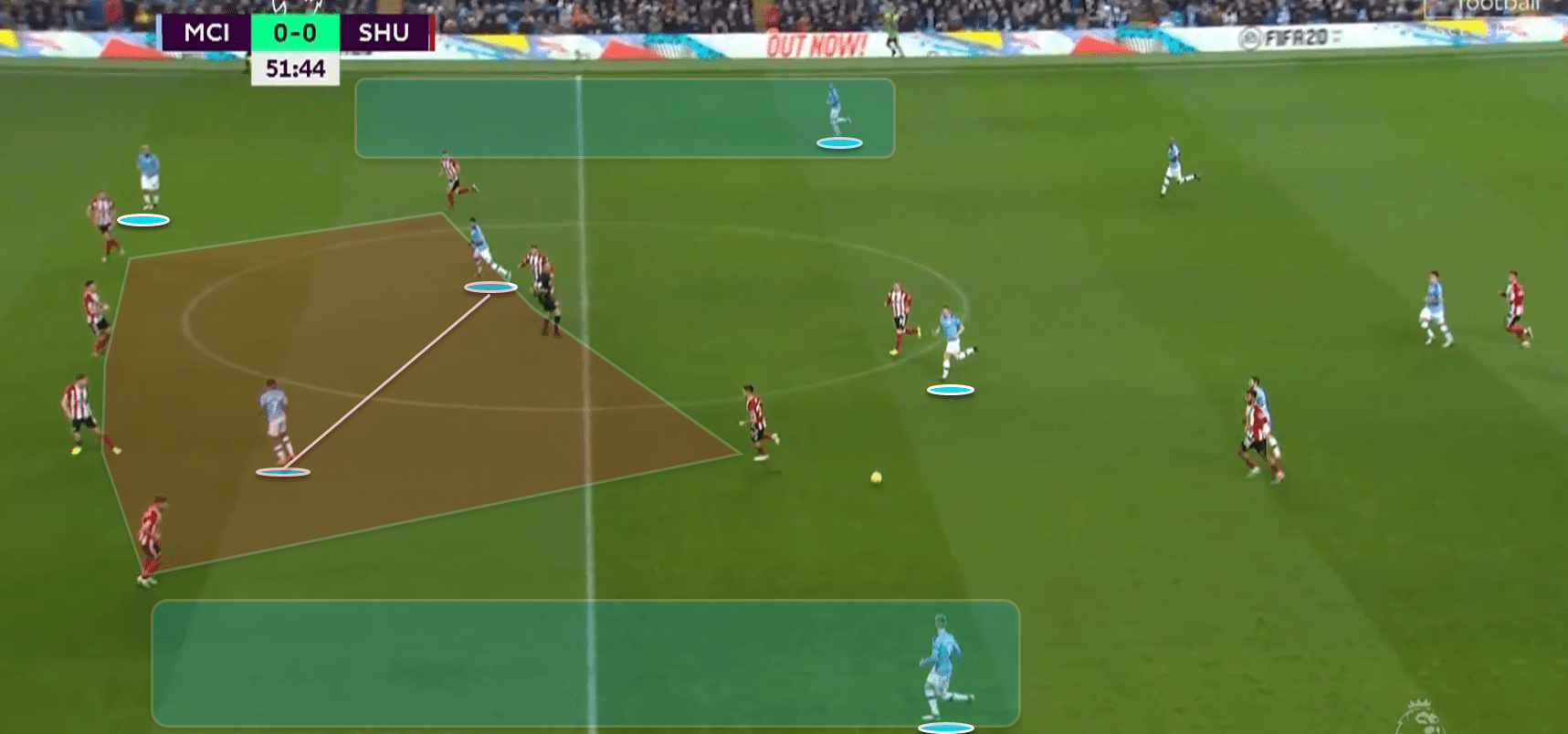
We see in this example how much space the City fullbacks had to advance into as they moved into advanced positions. I have also highlighted the space between the United midfield and defence and we can see that Raheem Sterling and Riyad Mahrez are positioned in that space. As the ball moved into the wide areas as we see above the fullback can either advance forward into that space or feed the ball centrally where there are three City players looking to pick up possession to attack the back
Conclusion
It is a mark of how impressive Sheffield United were in this match that Pep Guardiola had to completely change his tactics at half time. The breakthrough goal for City came after the referee blocked a United player allowing City to regain possession in the final third. Before that point City looked short of ideas and their passing was less incisive than we are used to seeing. We have to consider, however, that these issues when passing the ball were caused by the system of United. Countless teams have come away from matches with Wilder’s men this season bemoaning their own poor performances. At some point, we have to accept that these are caused by a very well-coached team. This Sheffield United team are going to be a fixture at this level for some time to come.

If you love tactical analysis, then you’ll love the digital magazines from totalfootballanalysis.com – a guaranteed 100+ pages of pure tactical analysis covering topics from the Premier League, Serie A, La Liga, Bundesliga and many, many more. Buy your copy of the December issue for just ₤4.99 here






Comments